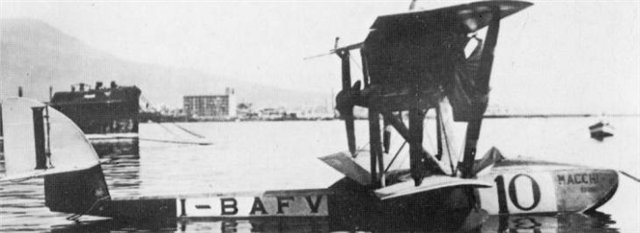Macchi M.7 on:
[Wikipedia]
[Google]
[Amazon]
 The Macchi M.7 was an Italian single-seat fighter
The Macchi M.7 was an Italian single-seat fighter

 The Macchi M.7 was an Italian single-seat fighter
The Macchi M.7 was an Italian single-seat fighter flying boat
A flying boat is a type of seaplane with a hull, allowing it to land on water. It differs from a floatplane in having a fuselage that is purpose-designed for flotation, while floatplanes rely on fuselage-mounted floats for buoyancy.
Though ...
designed by Alessandro Tonini and built by Macchi. A modified version of the M.7, the M.7bis won the Schneider Trophy
The Coupe d'Aviation Maritime Jacques Schneider, also known as the Schneider Trophy, Schneider Prize or (incorrectly) the Schneider Cup is a trophy that was awarded first annually, and later biennially, to the winner of a race for seaplanes and ...
in 1921.
Development
The M.7 was similar to the earlier M.5 but had a modified hull and was powered by an Isotta Fraschini V.6 engine. Due to the end ofWorld War I
World War I or the First World War (28 July 1914 – 11 November 1918), also known as the Great War, was a World war, global conflict between two coalitions: the Allies of World War I, Allies (or Entente) and the Central Powers. Fighting to ...
, only 17 aircraft were delivered to the Italian Navy. In 1919, two were sold to Argentina and four to Sweden, and in 1921, Brazil bought three.
In 1920, Tonini designed the M.7bis a racing version of the M.7 for the Schneider Trophy. The M.7bis had a lighter structure and reduced-span wings. Five M.7s entered the 1921 competition at Venice, which was won by Giovanni di Briganti flying the M.7bis. At the 1922 competition at Naples, the M.7bis came in fourth.
In 1923, a revised variant of the M.7, the M.7ter appeared. This had a redesigned hull, revised wing configuration and a new tail unit. Three different versions of the M.7ter were built, including the M.7ter AR, which had folding wing
A folding wing is a wing configuration design feature of aircraft to save space and is typical of carrier-based aircraft that operate from the limited deck space of aircraft carriers. The folding allows the aircraft to occupy less space in a co ...
s to allow them to operate from the seaplane-carrier '' Giuseppe Miraglia''. In 1924, six Italian naval squadrons were equipped with the M.7ter and over 100 were built. The aircraft was also used as late as 1940 by civilian flying schools.
Operators
; *Argentine Naval Aviation
The Argentine Naval Aviation (', COAN) is the naval aviation branch of the Argentine Navy and one of its four operational commands. Argentina, along with Brazilian Navy, Brazil is one of two South American countries to have operated two aircraft c ...
;
*Brazilian Naval Aviation
The Brazilian Naval Aviation () is the air component of the Brazilian Navy, currently called ''Força Aeronaval''. Most of its air structure is subordinated to the Naval Air Force Command (''Comando da Força Aeronaval'', ComForAerNav), the milita ...
;
*Regia Marina
The , ) (RM) or Royal Italian Navy was the navy of the Kingdom of Italy () from 1861 to 1946. In 1946, with the birth of the Italian Republic (''Repubblica Italiana''), the changed its name to '' Marina Militare'' ("Military Navy").
Origin ...
**Italian Naval Aviation
The Italian Naval Aviation () is the Naval aviation, naval air component of the Italian Navy composed of around 2000 men and women and 69 aircraft and helicopters.
History
It is more commonly known as Naval Aviation as it received various of ...
;
* Paraguayan Air Force
;
*Swedish Air Force
The Swedish Air Force ( or just ) is the air force Military branch, branch of the Swedish Armed Forces.
History
The Swedish Air Force was created on 1 July 1926 when the aircraft units of the Army and Navy were merged. Because of the escalatin ...
Surviving aircraft
A single Macchi M.7 has survived to this day. It was built in Italy around 1918 and was used by the Swedish Air Force from 1921 to 1927. It is now on display in the Swedish Air Force Museum with Swedish insignia.Specifications (M.7ter)

See also
References
* * {{Authority control Schneider Trophy 1910s Italian fighter aircraft Flying boats M.07 Biplanes Single-engined pusher aircraft Aircraft first flown in 1918